Flat Roofs
In Knoxville, TN, flat roofs are increasingly becoming the top choice for commercial buildings.
They offer unmatched cost-efficiency, straightforward installation, and a modern, sleek aesthetic that can transform the look and functionality of any structure.
But there’s more to flat roofs than meets the eye.
Whether you’re considering a new installation or looking to repair an existing one, understanding the benefits, types, and maintenance tips is crucial for making an informed decision.
Explore everything you need to know about flat roofs and why they might be the perfect fit for your commercial property.
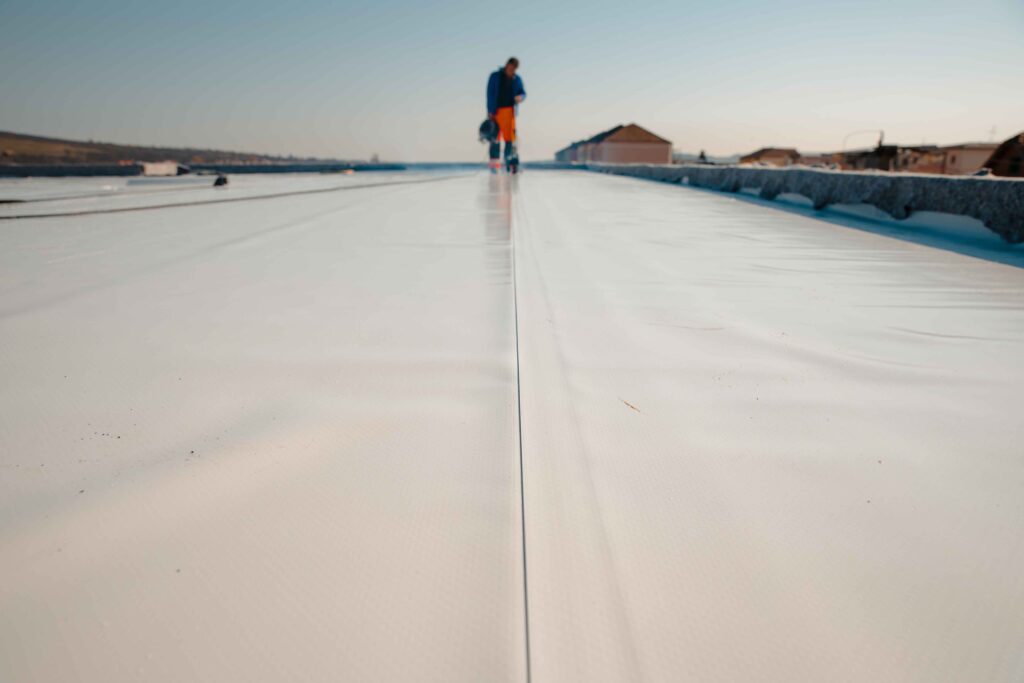
Benefits of Flat Roofs
Cost-Effective
Flat roofs are generally less expensive to install and maintain compared to pitched roofs. The materials used, such as single-ply membranes or modified bitumen, are often more affordable, and the installation process is quicker, reducing labor costs. The simplified design minimizes the need for complex structural components, further cutting down on expenses. The average cost of installing a flat roof ranges from $3 to $10 per square foot, depending on the materials and labor costs.
Easy Maintenance
The accessibility of flat roofs makes them easier to inspect and repair. Routine maintenance tasks, such as cleaning gutters and checking for leaks, can be performed without specialized equipment. This ease of access ensures that small issues can be addressed promptly, preventing them from escalating into more significant, costly problems. Maintenance costs for flat roofs typically range from $0.10 to $0.25 per square foot annually, making them a cost-effective option for property owners.
Space Utilization
Flat roofs can be used as additional space for HVAC units, solar panels, or even rooftop gardens, maximizing the utility of your commercial property. This additional space can also be transformed into recreational areas or green roofs, contributing to the building’s overall functionality and environmental footprint. For instance, green roofs can reduce stormwater runoff by up to 50%, improving urban water management and reducing the burden on local drainage systems.
Modern Aesthetic
Flat roofs provide a sleek, contemporary look that is appealing for many commercial properties, aligning with modern architectural trends. This design flexibility allows for creative architectural elements and can enhance the visual appeal of your building, making it more attractive to tenants and customers. Modern flat roof designs can also incorporate features like skylights and solar tubes, enhancing natural light within the building and reducing energy consumption.
Types of Flat Roofs
There are several types of flat roofing materials commonly used in commercial buildings in Knoxville:
1 .Built-Up Roofing (BUR)
This traditional roofing system consists of multiple layers of bitumen and reinforcing fabrics, creating a durable and waterproof membrane. BUR is known for its strength and longevity, making it a reliable choice for high-traffic areas. A typical BUR system can last 20 to 30 years with proper maintenance. The multiple layers provide excellent protection against water infiltration and mechanical damage.
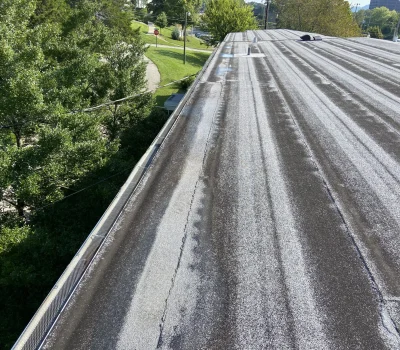
2. Modified Bitumen
Similar to BUR, modified bitumen roofing involves layers of asphalt mixed with plastic or rubber additives, providing enhanced flexibility and resistance to temperature fluctuations. This material is particularly well-suited for buildings that experience significant temperature variations. Modified bitumen roofs can also be applied using various techniques, including torch-applied, cold-applied, and self-adhering systems, offering versatility in installation.
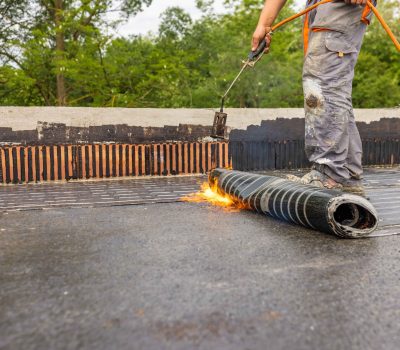
3. Single-Ply Membranes
This category includes TPO, PVC, and EPDM roofing systems, which are known for their durability, energy efficiency, and ease of installation. TPO and PVC are reflective, helping to reduce cooling costs, while EPDM is highly resistant to UV radiation and weathering. Single-ply membranes are typically installed in large sheets, reducing the number of seams and potential points of leakage. These systems can last 20 to 30 years and often come with warranties ranging from 15 to 30 years.
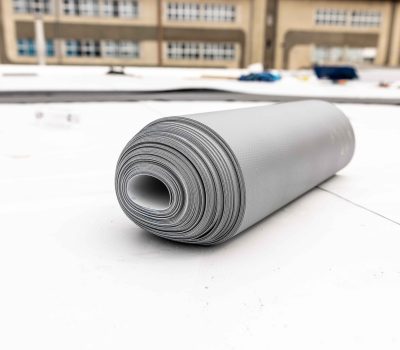
4. Spray Polyurethane Foam (SPF)
SPF roofing involves spraying a foam insulation layer onto the roof surface, creating a seamless, waterproof barrier with excellent insulation properties. SPF roofs are highly durable and can adapt to any roof shape, providing comprehensive protection against leaks. SPF roofs offer an R-value of approximately 6.5 per inch of thickness, making them one of the most effective roofing insulation options available. They can also help reduce energy costs by 30% or more by improving thermal performance.

Maintenance Tips for Flat Roofs
Proper maintenance is crucial for extending the lifespan of your flat roof. Here are some essential tips:
Regular Inspections
Conduct bi-annual inspections, particularly after severe weather, to check for signs of damage or wear. Look for cracks, blisters, and punctures in the roofing material. Early detection of potential issues can save you from costly repairs in the future. Regular inspections can extend the life of a flat roof by up to 25%.
Clean Debris
Remove leaves, dirt, and other debris from the roof surface and gutters to prevent water accumulation and drainage issues. Clogged drainage systems can lead to ponding water, which can weaken the roof structure and lead to leaks. Regular cleaning can also prevent the growth of moss and algae, which can cause damage to the roofing material.
Check Seals and Flashing
Inspect the seals and flashing around roof penetrations, such as vents and HVAC units, to ensure they are intact and watertight. Damaged or deteriorated seals can allow water to infiltrate, causing damage to the roof deck and interior of the building. Flashing should be checked for rust, cracks, and gaps that can compromise its effectiveness.
Address Leaks Promptly
If you notice any signs of leaks, such as water stains or damp spots on the ceiling, address them immediately to prevent further damage. Use appropriate repair materials and techniques to ensure a long-lasting fix. Leaks that are left unaddressed can lead to significant structural damage, mold growth, and higher repair costs.
Advantages and Disadvantages of Commercial Roof Systems
| Type | Advantages | Disadvantages |
|---|---|---|
| Built-Up Roofing (BUR) | Durable, excellent waterproofing | Heavy, labor-intensive installation |
| Modified Bitumen | Flexible, temperature-resistant | Prone to punctures, requires maintenance |
| Single-Ply Membranes | Durable, energy-efficient, lightweight | Higher initial cost |
| Spray Polyurethane Foam | Seamless, excellent insulation | Requires professional installation |
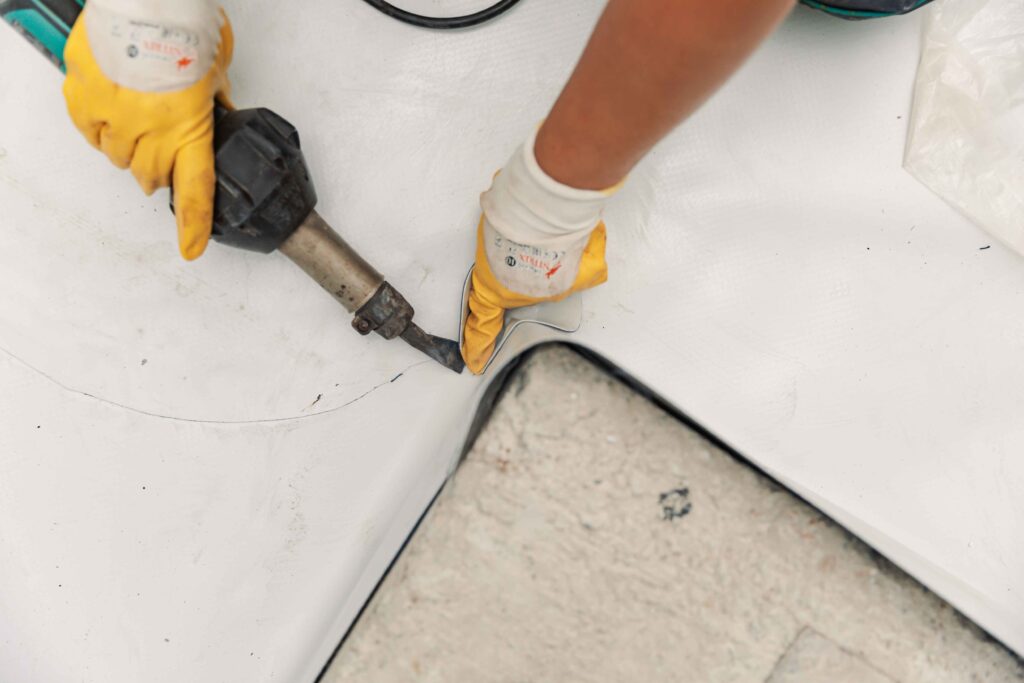
Local Considerations for Knoxville, TN
Knoxville’s climate poses specific challenges for flat roofs. With hot, humid summers and mild winters, selecting materials that can withstand temperature fluctuations and high humidity is essential. Additionally, consider the following:
UV Resistance
Choose roofing materials with UV-resistant properties to protect against the harsh sun during the summer months. UV radiation can degrade roofing materials over time, leading to cracks and leaks. Reflective roofing materials, such as TPO and PVC, can also reduce cooling costs by reflecting sunlight away from the building.
Insulation
Proper insulation is vital to maintain energy efficiency and reduce cooling costs during Knoxville’s hot summers. High-quality insulation can also help to minimize heat loss during the winter, contributing to overall energy savings. Insulation materials should have a high R-value to provide effective thermal resistance.
Storm Preparedness
Ensure your flat roof has adequate drainage systems to handle heavy rainfalls and prevent water accumulation. Installing additional drains or improving existing ones can help to manage stormwater effectively, reducing the risk of damage. Gutters and downspouts should be regularly cleaned and maintained to ensure proper water flow.
FAQs about Commercial Flat Roofs
Yes, flat roofs are versatile and can be used for various commercial buildings, including offices, warehouses, and retail spaces.
With proper maintenance, flat roofs can last between 20 to 30 years, depending on the material used. For example, EPDM roofs can last up to 30 years, while BUR and modified bitumen roofs typically have a lifespan of 20 to 25 years.
TPO and PVC single-ply membranes are popular choices due to their durability and energy efficiency. These materials are also resistant to UV radiation and chemicals, making them suitable for the local climate.
Flat roofs should be inspected at least twice a year and after severe weather events. Regular inspections help identify and address potential issues before they become major problems, extending the roof's lifespan.
Yes, flat roofs can support heavy equipment, such as HVAC units, but it's essential to ensure the roof is structurally sound. Proper load distribution and reinforcement may be necessary to prevent structural damage.
Common issues include leaks, ponding water, and punctures in the roofing material. These problems can be minimized with regular maintenance and timely repairs.
Yes, especially when using reflective materials like TPO and PVC, which can reduce cooling costs. Insulated flat roofs can also improve energy efficiency by reducing heat transfer.
Yes, flat roofs are generally easier to repair than pitched roofs due to their accessibility. Repairing a flat roof involves patching the damaged area and sealing it to prevent future leaks.
The cost varies depending on the material and size of the roof but typically ranges from $5 to $10 per square foot. Factors such as labor costs, roof complexity, and additional features (e.g., insulation, drainage systems) can also affect the overall price.
Web Ratings for Commercial Flat Roofing Companies
– Litespeed Construction: 4.8/5
– Yelp: 5/5
– Angie’s List: 4.6/5
– Knoxville Roofing Pro: 4.6/5
– Tennessee Weatherproof: 4.7/5
Maintenance of Flat Roofs in Knoxville, TN
Flat roofs offer a practical and aesthetically pleasing option for commercial buildings in Knoxville, TN. By understanding the benefits, types, and maintenance requirements, you can make an informed decision that enhances the longevity and functionality of your property.
Need a Roof Draining Help? Request A Free Estimate
For professional flat roofing services, choose a trusted contractor with a proven track record to ensure your investment is protected for years to come.
